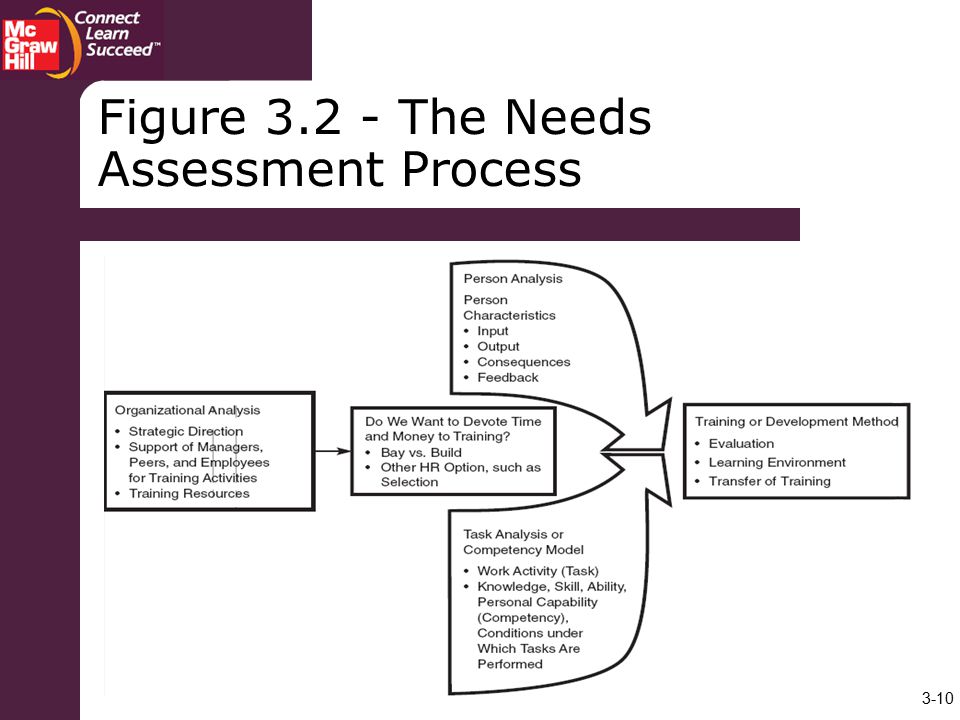 Source: http://rae-llc.com/wp-content/uploads/2010/05/puzzle.jpg
Source: http://rae-llc.com/wp-content/uploads/2010/05/puzzle.jpg
The organization I will be examining is a school which has been in existence for the past 10 years and is struggling sustain itself. The school runs from Kindergaten and runs through to Junior High. The organization, True Love School, seeks to provide quality education which equips its students with critical thinking and problem-solving skills to impact their local communities and larger society.
To be able to conduct a useful and meaningful assessment I will follow the Needs Assessment process
 Source: http://images.slideplayer.com/20/6006593/slides/slide_10.jpg
Source: http://images.slideplayer.com/20/6006593/slides/slide_10.jpg
I will need to seek buy-in from Upper level managers who are positioned to understand how training will support their business strategy. The owners of the school as well as middle level managers will need to support this drive and once this is achieved the employees of the company will also be roped in as they will also provide useful insight into developing an effective training program. In most organizations the employees to be trained are simply told to attend training however, it is becoming much clearer that “peer and manger support for training is critical, along with employee enthusiasm and motivation to attend training” (Noe, p. 122, 2013).
It will be useful to have specific insight from the following categories of stakeholders as follows:-
- Upper Level Management
- What is the business strategy?
- What is the perceived gap and what are possible causes?
- How employees are supported to complete their jobs.
- Which tools and resources are available at various levels of running the school?
2. Department Heads and Coordinators
- Which tools and resources are available at various levels of running the school?
- What is the perceived gap and what are possible causes?
- Are the tools and resources meeting their intended purpose or not.
- What is the perceived level of performance of employees.
- What learning opportunities available?
3. Teachers and Support Staff
- What is the perceived gap and what are possible causes?
- Are the tools and resources meeting their intended purpose or not.
- What is the perceived level of performance of employees.
- What learning opportunities available?
It will also be useful to see whatever policy documents are in place as well as past reports and implementation plans. Specifically, in the teaching area, it will be worth reviewing school standards against national standards. I would also use a mix of techniques but I will mostly interview groups of people and and take advantage of focus group approaches to allow me further explore responses obtained from the selective interviews.
This plan should provide adequate qualitative data to determine what the needs are and what training can solve.
Reference:
Noe, R. A. (2013). Employee training and development (6th ed.). New York, NY: McGraw Hill

Great blog post Ayeshat, thanks for sharing!
I think including every stakeholder is very important when it comes to training. Every person at every level is able to provide some sort of insight to ensure employees are on the right track. I like how you incorporated each role into your needs assessment.
Santana, you are right! It is important to engage all stakeholders in the training process. To reach out to upper level management, teachers and support staff as well as department head coordinators are of key importance to the success of the training.
Noe, R., (2013), in Employee Training and Development, explained that mutual planing and collaboration in training is key to the success of training, the application of content, the implementation of the instruction and the overall the success of the training and the organization’s future.
Reference:
Noe, R. A. (2013). Employee training and development (6th ed.). New York, NY: McGraw Hill.